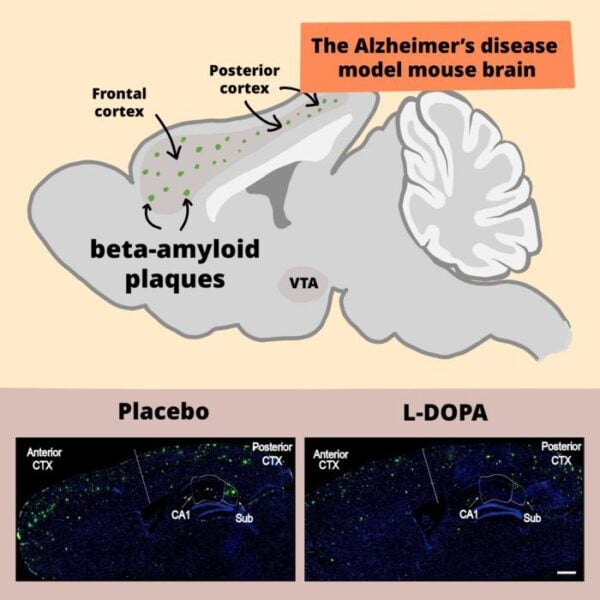Researchers at the RIKEN Center for Brain Science in Japan have uncovered a potential new approach to treating Alzheimer’s disease using dopamine. Their study, published in Science Signaling, demonstrates how dopamine treatment can reduce harmful brain plaques and improve memory in mice with Alzheimer’s-like symptoms.
Targeting Beta-Amyloid Plaques Through Neprilysin
The formation of beta-amyloid plaques in the brain is a key hallmark of Alzheimer’s disease, often beginning decades before noticeable symptoms appear. These plaques, made up of accumulated beta-amyloid peptide fragments, are thought to contribute significantly to the disease’s progression.
The research team, led by Takaomi Saido, focused on an enzyme called neprilysin, which can break down these harmful plaques. Previous studies had shown that increasing neprilysin levels in the brain through genetic manipulation resulted in fewer plaques and improved memory in mice.
However, genetic manipulation is not a feasible treatment option for humans. The challenge was to find a way to boost neprilysin levels using medication. After screening numerous molecules, the researchers discovered that dopamine could increase neprilysin production in cultured brain cells.
From Lab to Potential Treatment
To test this finding in living brains, the team used a technique called DREADD (Designer Receptors Exclusively Activated by Designer Drugs) to selectively activate dopamine-producing neurons in mice. This activation led to increased neprilysin levels and decreased free-floating beta-amyloid in the front part of the mouse brain.
The researchers then moved on to a more clinically relevant approach. They treated Alzheimer’s model mice with L-DOPA, a dopamine precursor molecule commonly used to treat Parkinson’s disease. L-DOPA can cross the blood-brain barrier and be converted into dopamine in the brain.
The results were promising. After three months of L-DOPA treatment, the mice showed:
1. Increased neprilysin levels
2. Decreased beta-amyloid plaques in both frontal and posterior parts of the brain
3. Improved performance on memory tests compared to untreated mice
Watamura Naoto, the study’s first author, stated, “We have shown that L-DOPA treatment can help reduce harmful beta-amyloid plaques and improve memory function in a mouse model of Alzheimer’s disease.”
These findings open up new possibilities for Alzheimer’s treatment, potentially offering a way to intervene at earlier stages of the disease. However, the researchers caution that more work is needed before this approach can be tested in humans.
“L-DOPA treatment is known to have serious side effects in patients with Parkinson’s disease,” Naoto explains. “Therefore, our next step is to investigate how dopamine regulates neprilysin in the brain, which should yield a new preventive approach that can be initiated at the preclinical stage of Alzheimer’s disease.”
The study also revealed that neprilysin levels naturally decrease with age in normal mice, particularly in the frontal part of the brain. This suggests that neprilysin could potentially serve as a biomarker for early Alzheimer’s disease diagnosis.
Why it matters: Alzheimer’s disease affects millions of people worldwide, with current treatments offering limited benefits. This research presents a novel approach that could potentially slow or even reverse the progression of the disease by targeting the underlying pathology. If these results can be replicated in humans, it could lead to more effective treatments for Alzheimer’s, improving the quality of life for patients and their families.
If our reporting has informed or inspired you, please consider making a donation. Every contribution, no matter the size, empowers us to continue delivering accurate, engaging, and trustworthy science and medical news. Independent journalism requires time, effort, and resources—your support ensures we can keep uncovering the stories that matter most to you.
Join us in making knowledge accessible and impactful. Thank you for standing with us!

